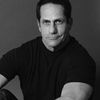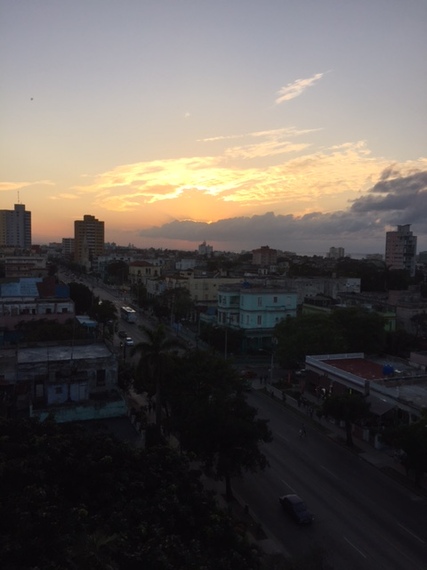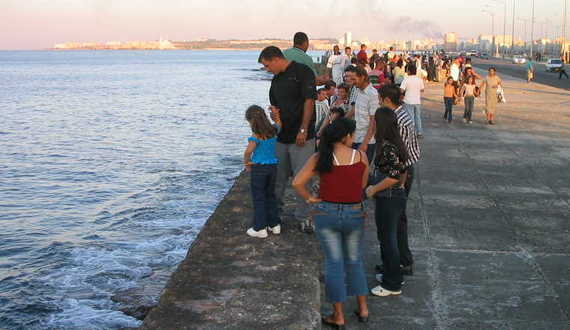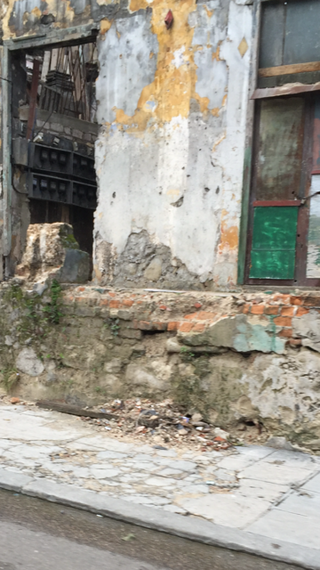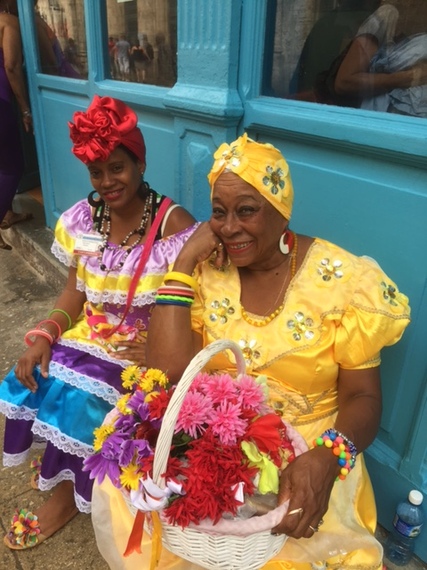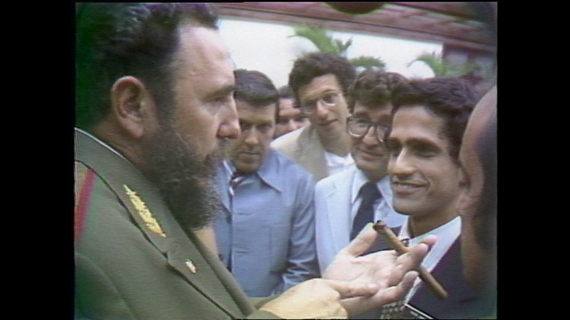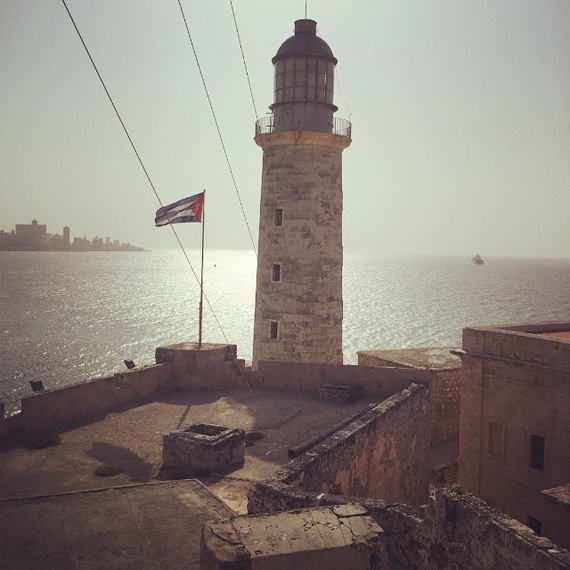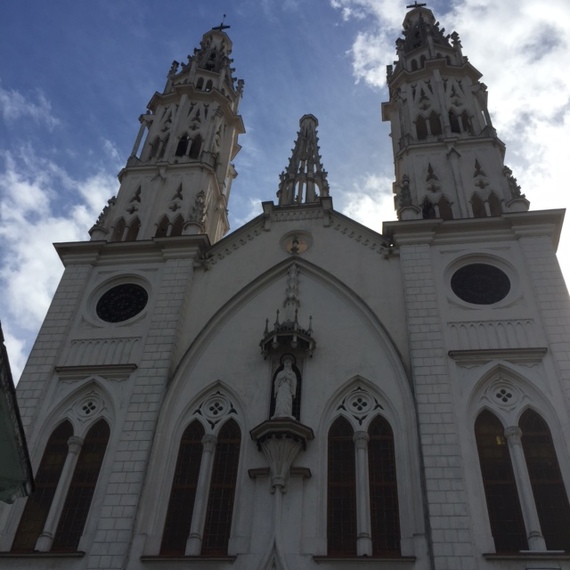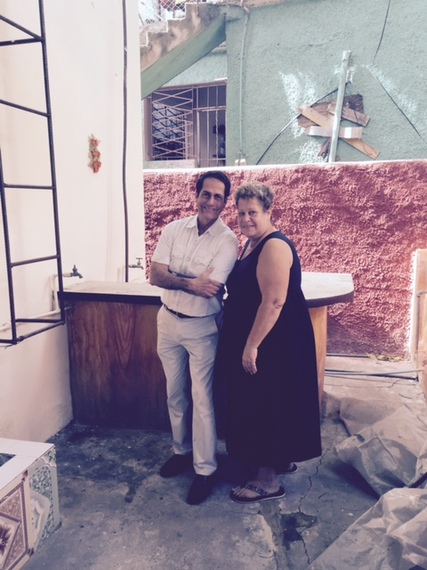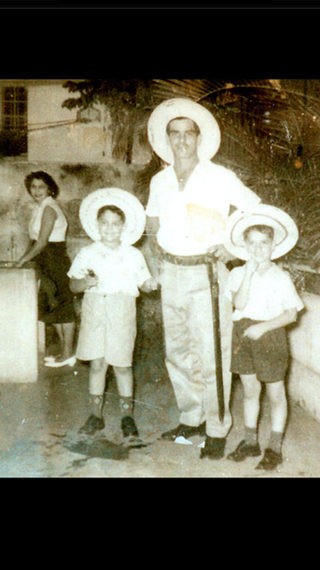I returned recently from a magic-carpet-ride-of-a-trip to my parents homeland--Cuba. I felt a mixture of optimism and sadness. I felt optimism that renewed relations between the U.S. and Cuba could bring changes for the Cuban people who have suffered so much for so long. And I felt sadness for what has been allowed to dissipate in this once splendorous land--the tropical paradise of our collective dreams.
A faded Havana-- her cloak now in tatters, her visage emaciated-- greets visitors. Crumbling facades in pastel hues look like they may simply disappear into the sea. The sea that separates us. But along the Malecon seawall, in the laughter of young people, there is a sense of hope. I went to Cuba to retrace my father's footsteps, photograph the home he lived in (in La Vibora), the bodega where he met my mother, the streets where he played with his friends. And in a Havana home that my brother and I visited as children in 1959, I joyously found a cousin my family never knew existed. We wept as we embraced for the first time. Her name is Tania. And now she joins our family. And we join hers. During my week long stay, I also met with Cuban professionals and regular Cubans, all struggling to make sense of the U.S. -Cuba initiatives. Would they bring change and a possible lifting of the embargo? More importantly, would the easing of restrictions herald the beginning of a new Cuba? Or simply more of the same? This is what I found.
On a Thursday evening in Havana's verdant Miramar neighborhood, the unmistakable sounds of Cuban jazz emanated from a popular nightspot named "El Diablo Tun Tun." On a stage bathed in lavender and blue lights, Ray Fernandez, a pint-sized "trovador" in a mustache and scruffy beard, strummed a guitar. He crooned folksy laments that at times poked fun( and in some cases even dared to question) the Castro government. Accompanied by a four piece band and two female back-up singers, Fernandez sang to a packed house of well-dressed professionals. They sang along to the lyrics and cheered when Fernandez mentioned Obama and the current political rapprochement. At another time, Fernandez may have been yanked off the stage or reprimanded by authorities. But in the new climate, repression appears to have been replaced by tolerance.
"After the fall of the Berlin Wall and especially in recent times as the image of Fidel as an omnipresent figure has diminished, certain kinds of protest have been tolerated by the state," explains Oscar Gonzalez, a researcher at the University of Havana. "Those include 'trova' music and songs which are political, personal and timely. In this case Ray Fernandez is describing certain realities of the Cuban experience in a joking manner." And irreverently as well. In one of the reggaeton-styled songs performed on the night I attended, the singer's saucy lyrics gently chided the regime. Fernandez called on President Obama to lift the embargo while urging Cuba to open itself to the world.
From Fernandez to Cubans I interviewed (including filmmakers, doctors, architects and street vendors) there seemed to be willingness to openly question the state. A year after the American flag unfurled over the U.S. Embassy in Havana for the first time in decades, many Cubans wonder when promised changes will materialize. Ernesto, a taxi driver for 28 years, who keeps his 1948 Chevy in tip-top shape for tourists, is skeptical. "So far the opening of the relations (the 'arpertura') hasn't meant too much to us," he says while driving his cab. "We're used to a lot of promises. They tell us: 'we'll let you sell your car, we'll let you sell your house legally, we'll let you buy a DVD,' but beyond that nothing has happened, absolutely nothing." Ernesto, wearing a Ralph Lauren polo shirt, wondered whether a Republican victory in November would derail the progress initiated by President Obama to stabilize relations between both countries and possibly end the embargo. "Hope always exists," he says sarcastically. "What doesn't exist are results. Our people don't see the end of the tunnel. It's a tunnel but you don't see the light."
But others are hopeful. They include filmmakers like Adolfo Mena Cejas . He's been invited to the U.S. in the Spring to show his short films. Mena Cejas points to the opening of private businesses in Cuba thanks to foreign investors. He invites me to meet him at one such tourist-friendly spot, the Waoo Snack Bar, just across the street from the Havana Libre Hotel. Food establishments such as Waoo are an alternative to state-run restaurants and Cuban "paladares' (restaurants run by Cuban "self-employers," usually from their home). Until recently such establishments outnumbered spots like Waoo which offers light-fare, lattes, cappuccino and strong Cuban coffee. "There have been changes," Mena Cejas says. He tells me of the opening of Wi-Fi zones in Havana. For roughly the equivalent of three dollars, one can purchase a "Nauta' (navigator) card from ETECSA (Cuba's telecommunications company) which provides access to the Internet for an hour. He shows me a strip of Havana's famed La Rampa (next to the Havana Libre Hotel) where Cubans, thanks to their "Nauta" cards, can be seen pecking away at cellphones and staring into lap tops. The zone, he explains, extends from 23 and L Street all the way to Havana's Malecon seawall. From teens to middle-aged Cubans, Internet fever has clearly hit Havana. Cubans can now access everything from Google to Facebook.
But others are hoping for more substantial change than simply Internet access. Gabriel Carillo, 58, sells periodicals such as "Juventud Rebelde," "Bohemia" and "Granma" (the Communist Party newspaper) to make a living. He says he hopes the hoped for lifting of the embargo may better the lives and wages of the average Cuban. "If more money comes into the island maybe things will improve," he says after eating ice cream at Havana's famed Coppelia Park. "But we worry a Republican will turn everything back." Carillo sells his papers in Havana and returns to his native Isla de la Juventud (the former Isle of Pines) once a year. "Here we like Obama because the "arpertura" (opening) could change things," he says. But the Cuban government continues to take a tough stance. On state-run television, I watched as officials demanded the U.S. return the naval base in Guantanamo before Cuba agrees to further talks. "On television you'll hear speeches that make you think we're back in the 60,'s," says Gonzalez. "On the one hand they (officials) want change, but they don't want to change the rhetoric. They want to be faithful to Fidel's teachings."
As Cubans ponder change, Americans like Elaine and Christopher Peake have come to Havana looking for investment possibilities. We met at the "El Floridita Bar," a favorite haunt of Ernest Hemingway in Old Havana. Peake is wearing a jaunty straw hat, looking very much like a character out of Graham Greene's novel "Our Man In Havana." "I want to be part of the new Cuba," says Peake, a former war correspondent in Central America for CNN News. "I want to play a role in the American entrance to Cuba business. It could include moving to Cuba. However, I want to set up two chandleries, two ship stores, on the two major marinas on the North shore of Cuba," he says. "There is no ship's store. If you need a part for your motor or tackle or rope or clothes, you're out of luck. It cannot be had here on this island."
The Peakes have started a website called cubastructure.com. A statement informs visitors: " Events are changing almost more rapidly than we can keep up and everyday and increasing numbers, U.S. businesses make planes to go to Cuba and start a business. With these startups come U.S. employees to open and run them and there is no template for moving to and living in Havana; life for Americans living in Havana has been a baptism by fire." Despite growing U.S. interest in starting businesses here, investing unilaterally in Cuba is still a dream until the trade embargo is lifted. That hardly deters Cuba-aficionados like Elaine Peake. " I think that right now this country is about to explode," says Peake a former news executive . "We just found out yesterday from Ernst and Young that with Venezuela pulling out, this country is going to hit a two year spiral if you will in which the country could go into a self imposed depression," she says. "Americans can come to this country and make a difference, just by visiting."
And visiting they are. Americans are among the thousands of tourists flocking to Old Havana. I watch them stroll down cobblestone streets and listen to street bands playing traditional Cuban "sons." They pose for photographs outside the Cathedral of Havana and snap pics of local curiosities like the colorfully dressed lady puffing away at a Cuban cigar. I watch them gaze at the intricate curved stained glass windows above graceful archways in the plazas. I stand behind them as they listen to the ubiquitous "guayabera"-clad Cuban street musicians. "Los cantantes" (the singers) warble "Son Cubanos" (soulful laments accompanied by Afro-Cuban percussion) while gently shaking maroon maracas, strumming guitars and drumming on bongos Desi-Arnaz style. Although purely touristic travel (such as stays at beach resorts) by U.S. citizens is strictly prohibited, the website legalcubatravel.com lists the catergories under the U.S. government allows Americans to travel. Those include "people to people exchanges, educational activities, professional research and meetings, humanitarian projects and family visits to close relatives in Cuba." U.S. citizens are expected to spend several hours a day on "person-to-person" exchanges with Cubans, according to the website.
As for myself, I came to Cuba in an attempt to convince my father (who lives in Florida) to return for a visit and connect with his past. By taking photographs of places where he lived and played, I hoped to influence his decision to one day join me. He left Cuba in 1945, and except for a brief visit in 1959, has never been back. I visited Cuba 16 years ago. I also visited as a CBS News Correspondent in 1980 at the height of the Mariel Boatlift (which brought 125,000 Cubans to the U.S). Almost three years earlier I had come to Cuba, then as a young reporter for WBBM-TV in Chicago. I accompanied U.S. businessmen who visited the island for the first time to explore future business possibilities. During that trip I interviewed then-President Fidel Castro. Smoking a cigar and joking, Castro expressed hope that relations between the U.S. and Cuba might one day improve. That day came last year when President Obama announced that the U.S. and Cuba would renew diplomatic relations.
On a recent balmy Havana morning , I ride in an impeccably-preserved 1948 Chevrolet(Cubans call their old American cars ""almendrones")) to the La Vibora, a section of Havana where my dad grew up. Leaving central Havana, I stare at "El Morro," the fortress guarding the entrance to Havana Bay. Huge waves crash on the rocks below it, against the backdrop an azure-colored Havana sky. On the way I notice homes in alarming states of disrepair. On one,the paint fades into ugly shades of yellow and gray. Other homes are in ruins--a few orange bricks here and there still peeking from crumbling structures. We first stop at Los Pasionistas de La Vibora Church where my father married my mother in 1951. I take photographs of the ornate spindly church steeples and of the long aisle down the center of the church leading to the altar. I can envision my mother in her lace wedding dress walking ever-so- slowly toward my father to the strains of the "Ave Maria." A few blocks away, I take photos of the home where my father lived and of the bodega where he worked as a teenager. It was in the "bodegita" while grinding coffee that he first met my mother. Some of the buildings that meant so much to "papi" have been demolished and rebuilt, with imposing gates shielding them from view. Would my father recognize them if he returned today?
Last stop is the home where my brother and I stayed with my mother during a brief visit more than five decades ago. It was the Summer of 1959 and Castro invited the militiamen who had fought with him in the mountains to come into Havana. From the porch , we waved, held tiny Cuban flags and cheered as the men drove by in caravans. Castro had still not declared that his revolution was a socialist one. As my taxi driver stopped in front of the home, I instantly recognized the porch. I ran out and began shouting "Hola." Soon a smiling woman in her 60's bounded out. I peppered her with a litany of names. They belonged to relatives on my father's side of the family. Did she recognize any of them? "Of course I know who they are," the woman said. "Orfelina was my aunt and Godmother." Her name was Tania and she was a distant cousin. I started to weep as we hugged. She invited me into the home. It was preserved exactly as I remembered it in 1959. Tania took me to the backyard where I my mother washed clothes in an outside sink on the day the militiamen came to town. We posed with a soldier holding a machete. The sink had been replaced with a counter --but I still recognized it. I posed for a picture with Tania on the same spot. I knew that when my brother showed my father the pictures in days to come, that my dad would rejoice that I had found a new family member.
There are Cubans in the U.S. who criticize those who visit Cuba saying that tourism emboldens the regime at the cost of the people. But there is another reality: Possibility. An opened cage. An unlocked gate. For Cuban-Americans like myself--what we thought was lost forever--united families--may once again be joined together in a world just beyond our fears. It's a world that I only dreamed of---until now.
Gomez's upcoming memoir "Cuban Son Rising" will trace his family's journey of immigration from Cuba to the U.S. and recount a career in journalism spanning 27-years.
